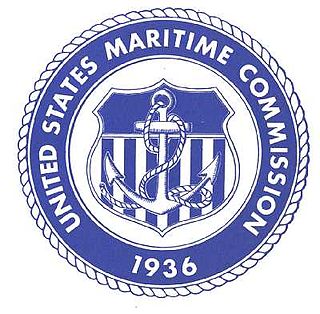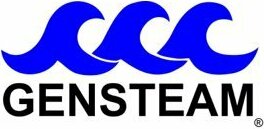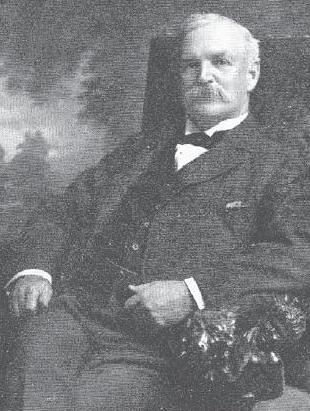Related Research Articles

Liberty ships were a class of cargo ship built in the United States during World War II under the Emergency Shipbuilding Program. Though British in concept, the design was adopted by the United States for its simple, low-cost construction. Mass-produced on an unprecedented scale, the Liberty ship came to symbolize U.S. wartime industrial output.

The United States Maritime Commission (MARCOM) was an independent executive agency of the U.S. federal government that was created by the Merchant Marine Act of 1936, which was passed by Congress on June 29, 1936, and was abolished on May 24, 1950. The commission replaced the United States Shipping Board which had existed since World War I. It was intended to formulate a merchant shipbuilding program to design and build five hundred modern merchant cargo ships to replace the World War I vintage vessels that comprised the bulk of the United States Merchant Marine, and to administer a subsidy system authorized by the Act to offset the cost differential between building in the U.S. and operating ships under the American flag. It also formed the United States Maritime Service for the training of seagoing ship's officers to man the new fleet.
A ship's hold or cargo hold is a space for carrying cargo in the ship's compartment.

The T3 tanker, or T3, are a class of seaworthy large tanker ships produced in the United States and used to transport fuel oil, gasoline or diesel before and during World War II, the Korean War and the Vietnam War. The T3 tanker classification is still used today. The T3 tanker has a full load displacement of about 24,830 tons.

SS Hagerstown Victory was a Victory ship-based troop transport built for the U.S. Army Transportation Corps (USAT) late in World War II under the Emergency Shipbuilding program. It saw service in the European Theater of Operations during 1945 and in the immediate post-war period repatriating U.S. troops. Hagerstown Victory was one of 97 cargo Victory ships converted to a troopship.

SS India Victory was a Victory ship built and operated as a cargo carrier and troopship in World War II. After the war the ship was used a private cargo ship. She sank on 12 July 1972, ran aground on a Pratas Reef in the South China in Typhoon Susan.

SS Augustana Victory was built and operated as Victory ship class cargo ship which operated as a cargo carrier in World War II, and Vietnam War.

SS Fordham Victory was built and operated as Victory cargo ship which operated as a cargo carrier in World War II. For the war she was operated by the Weyerhaeuser Steamship Company under charter with the Maritime Commission and War Shipping Administration.
South Atlantic Steamship Company was the passenger and cargo founded in 1928 in Savannah, Georgia that ran the South Atlantic steamship Line. At the started by chartering foreign ships to run the lines in tramp trade. Later scheduled cargo services was added to the line. In 1958 the company was taken over by United States Lines. In 1961 United States Lines closed the Atlantic steamship line and renamed the Atlantic steamship line ships. US homes ports were: Jacksonville, Florida, Savannah, Wilmington, North Carolina and Charleston, South Carolina. Main foreign ports were: London,Liverpool and Manchester UK. At its peak, it operated 60 ships during World War II. During World War II the South Atlantic steamship line was active with charter shipping with the Maritime Commission and War Shipping Administration. During wartime, the South Atlantic steamship line operated Victory ships and Liberty shipss.
Pacific Far East Line, also called PFEL in short, was a passenger and cargo shipping line founded in 1943 by Thomas E. Cuffe, in San Francisco, California. At the beginning he started by chartering foreign ships to run the lines in tramp trade. Later scheduled cargo services were added to the line. During World War II the South Atlantic steamship line was active with charter shipping with the Maritime Commission and War Shipping Administration.

General Steamship Company was founded in 1920 in Houston, Texas, as a Private Company, and now goes by Gensteam since 1996. General Steamship Company has a fleet of cargo ships that operate worldwide. Gensteam has a Gensteam Operations Desk website that tracks all shipping logistics. Gensteam headquarters is now in San Francisco, California. General Steamship Company was part owner of American Pacific Steamship Company in New York state and Los Angeles during and post World War II. American Pacific Steamship Company was founded in 1942 in New York City, and was previously called Los Angeles Tanker Operators Inc. which operated T2 tanker ships. During World War II the General Steamship Company and American Pacific Steamship Company were active with charter shipping with the Maritime Commission and War Shipping Administration.

Welding Shipyards was founded by American shipping businessman, Daniel K. Ludwig (1897–1992) in 1940 at Norfolk, Virginia on the Sewell's Point peninsula. Welding Shipyards build T3 tanker ships for World War II under the Emergency Shipbuilding Program. Welding Shipyards had one construction berth with 600 workers. The shipyard built what Ludwig was known for Oil tankers. Welding Shipyards built five type T3-S-BF1 tankers, the largest at the time. Ludwig' Welding Shipyards used what is called block construction. To shorten keel to ship launching time due losses to German U-boats, block construction was used. Ships blocks were built as the keel was being laid and then the prefabricated parts were then put in place and welded. With this construction time was reduced dramatically. Welding Shipyards and Ludwig had an important role in this new type of construction. All of the tanker ships were operated by Ludwig's shipping company that he founded, the National Bulk Carriers in 1936 in New York. National Bulk Carriers owned and operated oil tanker ships and bulk carriers. Some of the ships were among the largest in the world at that time. In 1953 Ludwig moved the shipyard operated to the Kure shipyard in Japan. Ludwig leased the Japanese navy Kure yard for 10 years. The Welding Shipyards site today is part of the Naval Station Norfolk. In 1940 and early 1941, Welding Shipyards converted older World War I surplus cargo ships into oil tankers.

World War II United States Merchant Navy was the largest civilian Navy in the world, which operated during World War II. With the United States fighting a world war in all the world oceans, the demand for cargo and fuel was very high. Cargo and fuel was needed around the world for the United States Navy, United States Army, United States Marine Corps, United States Army Air Forces, United States Coast Guard and the support of the allied nations of the United States. American steamship companies chartered ships from the Maritime Commission and War Shipping Administration to meet the demand. Many United States Merchant Marine ships were newly built in the Emergency Shipbuilding Program, other ships were older World War I ships that were put back in service, or private ships acquired under Emergency war requisitions. The Merchant Navy operated in the Pacific War and European war. Over 200 US Merchant ships took part in the D-day Normandy landings. To make a Normandy breakwater Harbor, called Mulberry harbour, 33 merchant ships were sunk 1,000 yards from shore. Some of the ghosts merchant ships used were damaged and others were deemed too old.

Cosmopolitan Shipping Company, also called the Cosmopolitan Line, was founded in 1916 in New York City. Cosmopolitan Shipping Company operated cargo and passenger service from New York City to Le Havre France and Antwerp. From 1919 to 1939 operated United States Shipping Board ships under a United States contract, called the America-France Line. Later Cosmopolitan Shipping Company also operated the Southern Cross Line that served the east coast of South America. Southern Cross Line operated cargo ship with some passenger accommodations.

Barber Asphalt Company of Washington, D.C. started in 1883 was founded by Amzi L. Barber. Barber, born in 1843. Barber first career was a teaching professor, he moved to real estate. In real estate, he found the problem of needing affordable paved roads. He found that asphalt was a great affordable material for paved roads. He added asphalt shingles to his products. In 1879 he moved Headquarters to New York City. He had offices in Washington, D.C. from 1878 to 1912, Philadelphia, Pennsylvania from 1912 to 1938 and Maurer, Perth Amboy, New Jersey from 1938 to 1948. In 1888 Barber leased the largest know asphalt deposit at Pitch Lake Trinidad. Barber opened a subsidiary, called the Iroquois division, and Iroquois Electric Refrigeration Company. Elkins Widener purchased the company in 1898 and merged with his Trinidad Corporation subsidiary. This formed the Asphalt Company of America of New York. In 1899 Asphalt Company of America was sold to John M. Mack and renamed, National Asphalt Company of America. In 1901 Barber retired from the Barber Asphalt Company. National Asphalt Company of America closed in 1902. In 1903 it opened again as General Asphalt Company. Uintah Railway Company was founded in 1903 by the Barber Asphalt Paving Company. Barber has paved millions of miles of roads. In 1904 Barber returned the company. In the 1920s Barber Asphalt Company opened a refinery in Perth Amboy, New Jersey at the time the town was known as Barber. The Barber Asphalt refinery is now the Perth Amboy Refinery. General Asphalt and Barber division merged in 1936. After the merger, the name was changed to Barber Company, Inc.. In 1938 the name was changed to Barber Asphalt Corporation. Barber Asphalt entered into a joint venture with Standard Oil Company of California in 1946. The joint venture was called California Refining Company.

Simpson Spence & Young, (SSY), Simpson Spence Young, Simpson, Spence & Young Ltd. was founded in 1880 by Ernest Simpson, Lewis Spence and Captain William Young in New York City. Ernest Louis Simpson started as a shipbroker from England. Simpson joined with shipbroker Lewis H. Spence and started Simpson & Spence in 1880. In 1882 Captain William Young joined the company and the name was changed to Simpson Spence & Young. Simpson Spence & Young opened a second office in Newcastle upon Tyne in England. Simpson son Ernest Aldrich Simpson (1897-1958) joined the company. The Simpson Spence & Young became very successful and becoming a worldwide shipping firm, with headquarters in London, one of the largest ship shipbrokers. Simpson Spence Young has 19 offices worldwide with over 400 people employees. Simpson Spence Young operates dry bulk, tanker ships, tugboats and has other services.
Prudential Steamship Corporation was a shipping company founded in 1933 in New York City by Stephan Stephanidis. Prudential Steamship Corporation operated the Prudential Lines. Prudential Lines main routes was from the United States to Mediterranean ports. The Prudential Lines was never successful and was always near bankruptcy. Prudential Lines was active in supporting the World War II efforts. At its peak in the 1960s Prudential Lines owned and operated two tankers, and five cargo ships. In 1960 the Prudential Steamship Corporation was sold to Spyros Skouras and his family. In 1969 the Prudential Lines merged with Grace Lines, which continued to operate the fleet as the Prudential Grace Line.
Sword Line Inc. was a steamship company founded by Charilaos "Charles" G. Poulacos and Abbott Abercrombie in New York City in 1933. Sword Line Inc. had shipping routes from Atlantic ports to and Gulf of Mexico ports. Charilaos "Charles" G. Poulacos and Abbott Abercrombie purchased the ship Eastern Sword in 1932. The Eastern Sword was a 3,785-ton cargo ship built in 1920 at the Uraga Dry Dock Co. Ltd, at Uraga, Japan. The ship sank after being hit by a torpedo from German submarine U-162 on May 4, 1942 twelve miles (19 km) off the coast of Georgetown, Guyana. The Eastern Sword had a crew of 38 and only 13 survived the attack. Sword Line Inc. was active in supporting the World War II effort.

American Petroleum Transport Corporation was an oil shipping company founded in New York City in 1936. Daniel K. Ludwig was President of American Petroleum Transport Corporation. In 1939 American Petroleum Transport Corporation operated eight tanker ships from the Gulf of Mexico to Hatteras, North Carolina. American Petroleum Transport Corporation was active in supporting the World War II efforts. Some tanker ships American Petroleum Transport Corporation operated were sunk by German U-boat submarines. Daniel K. Ludwig founded in 1936 the company National Bulk Carriers.

Sieling & Jarvis Inc. was a shipping company that operated tanker ships and some cargo ships. Sieling & Jarvis was started by David B. Jarvis and Dick Sieling in New York City. Later David B. Jarvis was the company president and later became the sole owner of Sieling & Jarvis Inc. Mr. Sieling was the vice president and a partner in Sieling & Jarvis. Sieling & Jarvis supported the World War II effort by operating United States owned ships.
References
- ↑ Proceedings of the Federal Inter-Agency Sedimentation Conference, 1963. Washington, D.C.: U.S. Department of Agriculture. 1965. p. 610. Retrieved 8 July 2015.
- ↑ Blume, Kenneth J. (2012). Historical Dictionary of the U.S. Maritime Industry. Scarecrow Press. p. 287. ISBN 9780810856349 . Retrieved 8 July 2015.
- ↑ Pace, Eric (29 August 1992). "Daniel Ludwig, Billionaire Businessman, Dies at 95". New York Times . Retrieved 8 July 2015.
- ↑ "National Bulk Carriers Inc". U.S. Securities and Exchange Commission. October 12, 2021.
- ↑ shipbuildinghistory.com Welding Shipyards
- ↑ REVIEW: HOW U.S. SHIPBUILDER DANIEL LUDWIG MODERNIZED JAPANESE SHIPBUILDING, by Stas, Feb. 3, 202
- ↑ World War II United States Merchant Navy
- ↑ "Sea Lane Vigilantes". www.armed-guard.com.
- ↑ World War II U.S. Navy Armed Guard and World War II U.S. Merchant Marine, 2007-2014 Project Liberty Ship, Project Liberty Ship, P.O. Box 25846 Highlandtown Station, Baltimore, MD
- ↑ t2tanker.org National Bulk Carriers
- ↑ wrecksite.eu Virginia